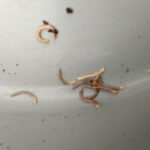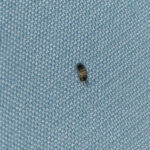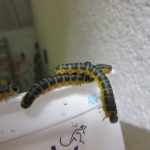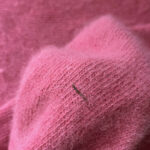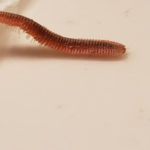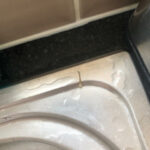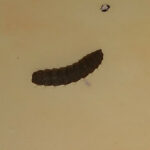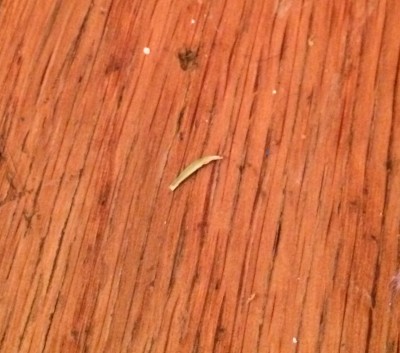
“Can you identify what kind of worm this is?” asks Amanda in her submission regarding the teeny tiny, brown worm-like critter pictured below. “This video was taken in our kitchen but we found one in our bed too. We live in Florida if that helps. Thank you!” Now, if it were not for the video that Amanda sent in, we would have no idea what this is. The picture is far too blurry to make out any of the tiny creature’s identifiable characteristics, other than its color and shape. But it was once we saw the video, which tells us how it moves and exposes more of its physical characteristics, that we were able to identify this as a millipede.
Generally speaking, people don’t like millipedes. Or their cousin the centipede, for that matter. The explanation is very simple: people do not seem to care for creatures with more than four legs. And millipedes have dozens of legs. In fact, their Latin name roughly translates to ‘thousand feet’, and the centipede’s name translates to ‘hundred feet’. The millipede and centipede share a number of characteristics, but they should not be confused with one another. While centipedes are fast predators with legs growing from the sides of their bodies, millipedes move quite slowly, are detritivores (meaning they eat already-dead organic matter), and have legs that sprout from the underside of their bodies. It is actually this last fact that often makes it difficult for people to identify millipedes, because, at sizes like the one Amanda found, the legs are often not very visible at first glance. But it is because of the positioning of their legs that they seemingly glide across a surface, just like the one in Amanda’s video: it was partly this reason that we were able to tell that it is a millipede in the first place.
The other characteristic that gave it away were its antennae. These antennae are used for sensory reception, much like a human’s ears and nose are used for senses. Millipedes use these antennae to get around, which is particularly helpful as they often find themselves in dark environments. In fact, some species of millipedes do not possess eyes, so they only have their antennae to ‘see’. Millipedes prefer dark and damp habitats, so Amanda probably caught these guys in the act of trying to find a place to hide away. Since she found these in two different locations, it is possible that she is experiencing an infestation. We recommend that she search the rest of her home for more millipedes. The best way to control and eliminate millipede infestations is to keep one’s home as warm and dry as possible, seal sizable cracks in walls and floors, mend or replace torn window screens, and remove piles of organic debris away from the outside walls of one’s home, and from one’s yard in general (millipedes congregate in these piles!). Naturally, we also suggest moving any millipedes she finds outside.
In conclusion, we believe Amanda found millipedes in her home. Although they are harmless (though they can secrete a smelly toxin that could cause irritation), we understand that having unwanted guests in one’s home is not pleasant. We hope this helps, and we wish Amanda the very best!
All About Worms is always free, always reader-supported. Your tips via CashApp, Venmo, or Paypal are appreciated! Receipts will come from ISIPP Publishing.
You might also find these guys interesting!




